|
| A |
 | Usage: answere
single compartment 'a' used throughout for the lower case graph. Here the head is flat with single fine stoke to join the two sides. |  | Usage: as
in this version the scribe adds an extra, thicker head stroke at an angle to the short down-stroke to the right. |
 | Usage: And
upper case 'A' is double compartment. The lower lobe may be sharply angled as here forming a triangular shape. |  | Usage: And
upper case 'A' with more rounded aspect. |
|
| D |
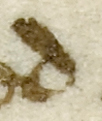 | Usage: god
the scribe uses a variety of 'd' graphs, both looped and unlooped. 'd' without an upper loop is most favoured in final position, but this is not a hard and fast rule. | 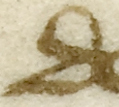 | Usage: do
looped 'd' with sharply pointed lower lobe is favoured for 'd' in initial position, but again it is not always the case. |
 | Usage: haed | 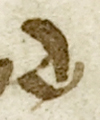 | Usage: payd
a hastily formed graph. |
|
| G |
 | Usage: began
lower case tailed 'g' varies only in the extent to which the top of the graph appears horned. | 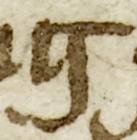 | Usage: kyng
the angle of the tail is fairly consistent. 'g' at the end of a word tends to have an extended horizontal slash. |
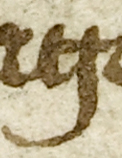 | Usage: age
a visibly horned graph. |  | Usage: God
upper case 'G' at the beginning of a line. |
|
| H |
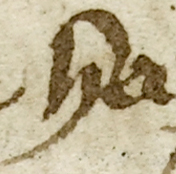 | Usage: haþ
a typical 'h' graph with thick arched head stroke and long tail-stroke descending from the limb and sweeping to the left beyond the stem of the graph. The angle of the tail gives the graph a slanted appearance. | 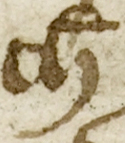 | Usage: which
in the 'ch' combination, 'h' is nearly always crossed. |
 | Usage: he
a word from the top line with extended stem into the top margin. | 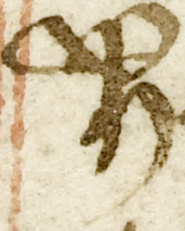 | Usage: Heraftir
an elaborate version of an upper case 'H' with looped addition to the left of the stem. |
|
| R |
 | Usage: remedyid
modern 'r' is used in initial, medial and final positions except after 'o' and sometimes after 'e' and 'a'. |  | Usage: for
'z'-shaped 'r' used after 'o'. |
 | Usage: yer
'r' in final position with circular flourish. |  | Usage: Reple
'R' as the first letter of the line. |
|
| S |
 | Usage: as
kidney-shaped 's' used almost exclusively in final position. |  | Usage: stonde
long 's' used in initial and medial positions. The descender is a thick stroke which extends well below the surrounding graphs. The head stroke joins the top of the stem with a fine line which thickens as it curves. |
 | Usage: staatys
a single sigma 's' in final position. |  | Usage: She |
|
| W |
 | Usage: now
this is the basic shape of the 'w' graph with two diagonal arms and short single stroke or lobe to the right. |  | Usage: were
in initial position, the scribe adds an elaborate curving approach stroke to most 'w's. On later folios, this stroke is finer and less obtrusive. Since the scribe also adds this stroke to other graphs it must have been a conscious decision perhaps as a decorative device. |
 | Usage: answere
there are one or two closed loop 'w' graphs with single lobe on the right side. They are all found where 'w' occurs within a word. |  | Usage: With
upper case graph at the beginning of a line. |
|
| Y |
 | Usage: may
the tail of 'y' is usually quite long. It may or may not turn counter-clockwise at the end. |  | Usage: hym
the tail of 'y' follows the descender of 'h' with no return stroke. |
 | Usage: dayes
sometimes the tail may extend below several other letters. |  | Usage: Ye
Upper case 'Y' at the beginning of a line. |
|
| Thorn and Yogh |
 | Usage: þat
the scribe uses thorn for 'th' in all the usual places and also for the present tense ending of some verbs. There is no regular pattern for usage. The stem of thorn is usually long, tapering in a slight curve. The lobe is set high on the stem and is quite small. |  | Usage: dulliþ |
 | Usage: ynouȝ
yogh is used as equivalent of 'gh'. |  | Usage: whyȝt |
|
| Upper Case Letters |
 | Usage: This |  | Usage: My |
 | Usage: Lo | 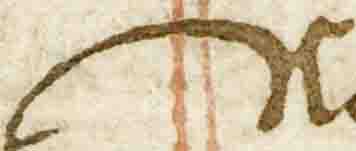 | Usage: Now |
|
| Otiose Strokes |
 | Usage: may
the scribe adds a curving stroke in front of several of his graphs. Since he does not always use it, it would seem to be a decorative addition which the scribe has applied, more frequently at the beginning of the manuscript than at the end. | 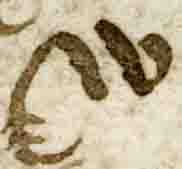 | Usage: wull
here the scribe has even decorated his otiose stroke. |
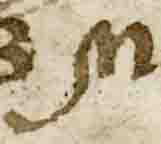 | Usage: nev |  | Usage: ampersand
even the ampersands attract this treatment. |
|
| Decorative Features |
 | Usage: I
decorative top to an upper case 'I' on the top line of a folio. |  | Usage: I
the same feature in context. |
 | Usage: Decorative scroll in the top margin of folio 52r. |  | Usage: Coat of arms in the central boss of the transverse bar of the border in the lower margin. |


















































